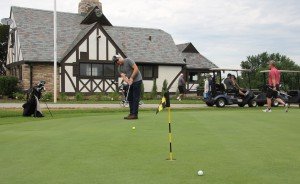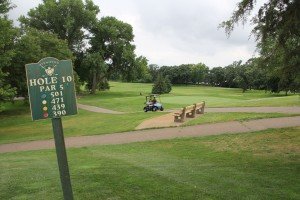As the Minneapolis Parks and Recreation Board (MPRB) of Commissioners begin discussing the future of Hiawatha Golf Course, golfers are ramping up their efforts to save the course.
Local resident Craig Nichols, who has golfed at Hiawatha all his life, started an online petition and is running a Facebook group called “Save Hiawatha Golf.” He presented a petition with over 1,200 signatures to the board during a July 19 public hearing.
“Hiawatha golf course has been a friendly and affordable home to golfers of the Twin Cities since 1934,” explained Nichols on the www.change.org petition page. “Through good times and bad, our families have been able to ‘escape’ to Hiawatha for a quick round and chat with friends.
 Photo right: Craig Nichols practices putting at Hiawatha Golf Course. He recently started the Facebook Page, “Save Hiawatha Golf.” “I did this because I wanted the youth of Minneapolis to be able to have the opportunity to learn a game they can play their whole lives and with that learn to be part of a community,” he explained. “I felt the park board was leaving golfers out of the conversation, and seemed to not want people to know what was happening. Did you know the golf course isn’t allowed to post anything about its own future at the course? Even so much as a notice that there will be a meeting? Makes a person wonder about their transparency a little doesn’t it?” (Photo by Tesha M. Christensen)
Photo right: Craig Nichols practices putting at Hiawatha Golf Course. He recently started the Facebook Page, “Save Hiawatha Golf.” “I did this because I wanted the youth of Minneapolis to be able to have the opportunity to learn a game they can play their whole lives and with that learn to be part of a community,” he explained. “I felt the park board was leaving golfers out of the conversation, and seemed to not want people to know what was happening. Did you know the golf course isn’t allowed to post anything about its own future at the course? Even so much as a notice that there will be a meeting? Makes a person wonder about their transparency a little doesn’t it?” (Photo by Tesha M. Christensen)
Hiawatha has a vibrant community of golfers from ages five to 85 that will have to find somewhere else to golf. Some of the younger and older golfers will have a difficult time getting to one of the suburban courses.
“Please convince the Minneapolis Park Board, the Minnesota DNR, and the Minnehaha Creek Watershed District to do their jobs and come up with intelligent solutions to solve the problems Hiawatha faces rather than just shut generations of golfers out.”
Some have commented that if the course was rearranged and used a modern design, less would be located in the lower elevations.
Golfers are also pushing the park board to hold off making a decision until after new park board members are installed in 2018.
“We’d like to see the vote on the course put off until the next board is in,” wrote Nichols on the Save Hiawatha Golf Facebook page. “We feel they are rushing this through since most aren’t running again.”
As of press time, the full Board of Commissioners planned to consider the water management recommendation at its Wed., Aug. 9 meeting.
Local commissioner Steffanie Musich has stated that she is refraining from making a final decision about pumping until the board has been provided with the final staff report and the public hearing has been held. She is one of the few board members who is planning to run for re-election.
Two options
MPRB staff, with the assistance of local firm Barr Engineering, have narrowed the options for Hiawatha Golf Course to two.
Option A would reduce the pumping there to 308 million gallons of groundwater, which keeps the course open.
Option B drops the pumping to 94 million gallons of groundwater, which would effectively flood much of the property and close the course while keeping neighboring basements dry.
 Photo left: For the past 10 years, Craig Nichols has lived within a few blocks of Hiawatha Golf Course. He values the course because it offers what others don’t by being the only course in Minneapolis fully within city limits. “Do people expect that kids from south Minneapolis will be able to get to Wirth or Gross, or Meadowbrook easily on their own?” he questioned. “It also has one of the most extensive practice area of any course in the metro, let alone the inner city,” Nichols added. Five high schools practice at Hiawatha, and other children participate in the First Tee program. (Photo by Tesha M. Christensen)
Photo left: For the past 10 years, Craig Nichols has lived within a few blocks of Hiawatha Golf Course. He values the course because it offers what others don’t by being the only course in Minneapolis fully within city limits. “Do people expect that kids from south Minneapolis will be able to get to Wirth or Gross, or Meadowbrook easily on their own?” he questioned. “It also has one of the most extensive practice area of any course in the metro, let alone the inner city,” Nichols added. Five high schools practice at Hiawatha, and other children participate in the First Tee program. (Photo by Tesha M. Christensen)
Without any pumping, the groundwater elevation underneath the golf course would rise by 4 feet and flood most of the course. MPRB has been pumping stormwater and groundwater off the course into Lake Hiawatha since the 1960s. The property was originally a wetland, called Rice Lake before it was dredged and the fill used to create a golf course, which is currently sinking.
Options A and B were presented to the public following a series of meetings regarding the issues at the course. During the April and May meetings, staff solicited opinions from the public about what they’d want on the land instead of a golf course, and suggestions were varied.
On June 21, staff announced that the Department of Natural Resources (DNR), which must approve the level of pumping at the property, favors Option B because it reduces pumping by 70% and is considered more sustainable and less costly in the long run.
However, the DNR will not make an official statement and decision about the project until the MPRB submits an appropriations permit application, and so some residents question whether the DNR is actually in favor of closing the course.
Would dredging solve the problem?
Other residents are pushing for MPRB to lower the level of the lake and dredge it and the creek to maintain the golf course.
Engineers have repeatedly said that dredging the lake would make it deeper but not lower the level of the lake, so it will not reduce pumping.
To lower the lake level, the outlet of the lake would need to be lowered. This could be accomplished by modifying an existing weir at 28th St. and another weir at Hiawatha Ave. It may also be necessary to dredge the creek between the two weirs. Lowering the lake would also result in lower water elevations in the creek downstream of the lake, and would affect how much flood storage is available both around Lake Hiawatha and farther downstream. Plus the project would require permits from several agencies.
Minnehaha Creek could be dredged, but not by more than one foot because of several utility crossings, including a Metropolitan Council Environmental Services (MCES) 11-foot diameter gravity sanitary sewer pipe. One foot deeper would not help the situation at Hiawatha, according to a MPRB face sheet available online.
However, if existing sanitary sewer pipes were protected in some way, MPRB could consider lowering 2,000 feet of channel to an elevation of 809, which would result in a slight reduction in the flooding at the Bloomington Pond Area/Sibley Pond and no impact in flooding at the Hiawatha west watershed.
There are three bridges/crossing downstream of Lake Hiawatha that would need to be modified or reconstructed to achieve the lower channel elevation, and the city water main upstream of 28th would need to be lowered. An abandoned CenterPoint gas main downstream of 28th would need to be removed. Additionally, the creek channel would need to be redesigned and restored to achieve a stable channel and banks, and it would take some time to re-establishing the existing biological communities.
If the pumping changes
If the pumping at the course changes, a master planning process will begin that will take 9-12 months and include input from a Community Advisory Committee. The course would continue to stay open, likely through the 2019 season.
• The highest number of rounds was 55,000 in 2001.
• The lowest number of rounds was 14,000 in 2014 when the course was flooded.
• The annual average rounds per year is 40,800.
• However, in the last six years impacted by flooding, wet conditions, and market changes, the average was 23,800.
• For the period before the wet years, the average annual revenue was $250,000.
• For the six years impacted by flooding, the average annual revenue was a loss of $180,000.
Comments
No comments on this item Please log in to comment by clicking here